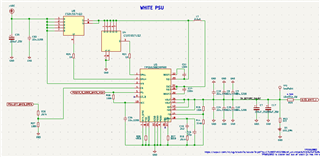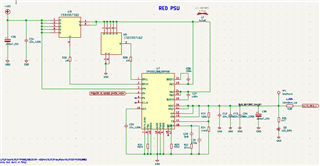Other Parts Discussed in Thread: CSD15571Q2, CSD16301Q2
Hi,
We're building an LED matrix display, and are using two independant TPS552882 power supplies. The design criteria for these two supplies is as follows:
- White LED supply: Vin 9-15 V, Vout 5 V, Iout <4.32 A
- Red LED supply: Vin 9-15 V, Vout 9.6 V, Iout <1.20 A
We've received our first prototype PCBAs, and the design does not work as expected. Notably, the 5 V supply gets too hot to touch, and the board draws 9 W on the input. We have shunt resistors for measuring the outputs from both TPS552882 supplies, so I disconnected these (thereby dropping all load from the supplies) and still measure 8.7 W draw - and the 5 V supply continues to get hot in operation. I don't have a thermal camera to know where the energy is going exactly - but it feels like it's the inductor.
I should note the output voltage on both supplies is correct (5 V and 9.6 V respectively), and I can even put additional load on the supplies. A 20 W load on the output still measured at 4.9 V - however the efficiency was only around 50-60%.
Yesterday, on another PCB, we spent some time trying different things. As we have two supplies, we tried swapping feedback resistors between them - the 9.6 V supply that seemed okay became very hot when set at 5 V. This test was not entirely comprehensive, as we didn't also change the compensation network. We did try swapping the inductors, and that didn't appear to have any effect (though we didn't measure output ripple, just output voltage, nor did we attempt to load the supply).
With no changes to the design, i.e. testing the schematic shown below, we measure 2 Vpp ripple on Vin (supplied with a quality bench power supply). With such a high ripple, I also measured the EN/UVLO which showed a lesser ripple and remained above 4 V.
One thing I noticed, upon reviewing our design against WEBENCH, is that our M2 MOSFET is not on the list of alternatives. We have the CSD15571Q2 in both the M1 and M2 positions for both supplies - however I couldn't find any design notes about the parameters of these FETs. Given our supply isn't operating correctly in low-load conditions, I figure the FET itself likely isn't the problem?
In any case, here's our two supplies:


Note the sequencing using the VCC and PG from the white supply to enable the red supply. We did suspect this may cause issues, and removed the white supply entirely (FETs, SMPS IC, etc) to try eliminating this as a cause. We were able to convert the red supply to 5 V (ignoring compensation network changes, and using the 4.7 uH inductor) and demonstrate the fault was still apparent. I should also note we've spent most of our time testing in the buck configuration. We did show the boost mode is functional, but we didn't do much more testing than that.
We've ordered some replacement FETs, the CSD16301Q2, which the WEBENCH recommended in both M1 and M2 positions. We've also ordered the TPS552882EVM-400K kit for further testing and experimentation.
Can you please review and comment on our design? I've been unable to simulate the design in WEBENCH (seems not available?), and I'm not sure exactly what this fault condition is caused by.
Kind regards,
Dan




